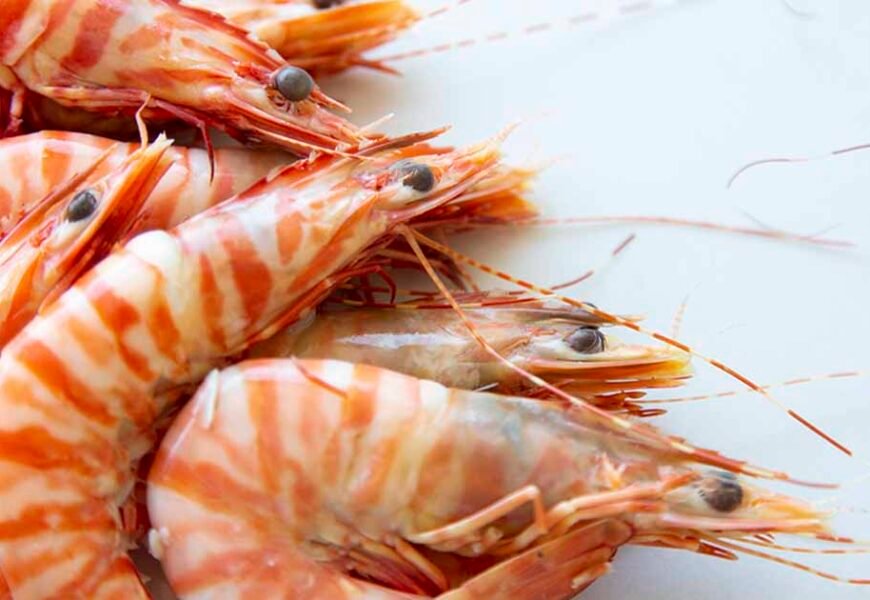Many recent headlines have screamed that shrimp are “on cocaine.” The short version: researchers testing river wildlife in parts of the UK found trace amounts of many contaminants — including cocaine — in every sample of the freshwater shrimp they examined.
That finding is real, but it needs context: the presence of trace drug residues in aquatic wildlife is an indicator of broader chemical pollution in waterways rather than a headline-friendly statement that shrimp are “high.”
Below I unpack the science, the environmental pathways, the real risks, the limits of the data, and how to read media coverage about this subject. Each point is expanded so you can understand the nuance and the implications for ecosystems, policy, and public health.
1) What the study actually tested and what the researchers reported
Researchers sampled freshwater invertebrates — primarily the amphipod Gammarus pulex (a common freshwater shrimp-like crustacean) — from multiple sites and used modern analytical chemistry to screen for hundreds of micropollutants.
The laboratory methods typically include extraction of tissue followed by sensitive mass-spectrometry techniques that can detect substances at nanogram-per-gram levels.
The work was a snapshot: samples were collected from specific rivers and sites at the time of study rather than an exhaustive national survey.
Scientists reported detecting dozens of different compounds across the samples, including pharmaceuticals, pesticides, and illicit drugs such as cocaine.
Cocaine was one of the most frequently detected illicit drugs — it showed up in every shrimp sample tested at the sites the researchers analyzed.
The researchers flagged detection frequency rather than claiming the shrimp were consuming enough drug to alter their behavior in the way a person would from drug use.
The presence of multiple contaminants is a marker of the number of substances reaching waterways from human activity — not proof that shrimp are “high” in the human sense.
Authors stressed surprise at how common certain traces were, which is why the study drew intense media attention.
The paper and university press materials emphasize environmental monitoring objectives: to identify what contaminants are present and to start asking how they might affect wildlife and ecosystems.
Study teams often include ecotoxicologists, analytical chemists, and environmental scientists who interpret detection patterns cautiously.
They are careful to separate detection (a chemical was measurable) from effect (a chemical caused measurable harm at that concentration).
In short: the lab reported trace detection of cocaine in all sampled freshwater shrimp at the surveyed sites; the detection is real, but interpretation requires nuance.
2) How drugs and pharmaceuticals get into rivers and end up in wildlife
Medicines, illicit drugs, and many household chemicals enter waterways primarily through wastewater — that is, human excretion and disposal that reaches sewage systems.
When people take medicines or use recreational drugs, unmetabolized residues and metabolites are excreted and flow into wastewater treatment plants.
Many wastewater treatment plants were not designed to remove the full range of modern micropollutants, so low concentrations of these compounds can pass through treatment and enter rivers via effluent.
Runoff from agriculture and urban surfaces can add pesticides and other chemicals to the mix, compounding the contaminant cocktail in rivers and streams.
Illegal sources can contribute too: leakage from clandestine drug labs, dumping by traffickers, and lost cargo during maritime incidents are all plausible localized inputs.
Storm overflows — when heavy rain overwhelms sewage systems — can flush raw sewage into rivers, increasing episodic loads of contaminants.
Once released into the aquatic environment, these chemicals disperse, adsorb to sediments, or are taken up by organisms at various trophic levels.
Small animals like freshwater shrimp are exposed through water, sediment, and by eating contaminated detritus or biofilm.
Because organisms live in the contaminated water continuously, they can serve as indicators or “sentinels” that reveal the presence of human-derived chemicals.
Researchers use such sentinel species to map contamination patterns and to prioritize sites for more detailed ecological impact studies.
Thus, the detection of cocaine in shrimp reflects a pathway from human activity — excretion, wastewater systems, and environmental release — into river ecosystems.
3) “Trace amounts” — what that phrase means and why concentration matters
When scientists say they found “trace amounts,” they mean concentrations often measured in parts-per-trillion or parts-per-billion (nanograms per gram or ng/g), which are extremely low.
Analytical instruments today are exquisitely sensitive and can reliably detect these minuscule quantities that would have been invisible to older methods.
A detection does not equal a toxic dose; toxicology is dose-dependent and varies across species — what harms a human may not harm a small crustacean and vice versa.
For many contaminants, especially psychoactive drugs, behavioural or physiological effects in wildlife may require concentrations much larger than the trace levels detected.
However, for some chemicals (endocrine disruptors, certain pesticides), biologically meaningful effects can occur at low concentrations or via chronic exposure.
Researchers evaluate not only single-compound concentrations but also the combined “mixture effects,” because multiple compounds can interact in complex ways.
Analytical detection limits, measurement uncertainty, and background environmental variability all influence how we interpret “trace” measurements.
Reporting should therefore include concentration ranges and detection frequencies rather than sensational phrases alone.
Public headlines often omit the concentration context, which can create misleading impressions of direct human health risk from eating the shrimp.
Scientists caution that trace detections warrant further study — to measure concentrations across seasons, sites, and species and to assess any ecological or food-safety consequences.
So: trace detection is an important early-warning signal, not proof of immediate poisoning or intoxication.
4) Potential ecological effects — why ecologists are concerned even at low levels
Aquatic organisms are adapted to narrow chemical environments; persistent, biologically active pollutants can alter physiology and behaviour even at low concentrations over time.
Psychoactive drugs in water can theoretically affect neurotransmission in invertebrates and fish, potentially changing feeding, predator avoidance, reproduction, or social behaviors.
Experimental studies in labs have shown that certain antidepressants, anxiolytics, and stimulants can alter fish and invertebrate behaviour at environmentally relevant concentrations.
Such behavioural shifts might ripple through food webs — for example, if prey become less able to evade predators, or predators change their hunting patterns.
Crustaceans like Gammarus play key roles in detritus breakdown and nutrient cycling; disrupting their normal activity could affect ecosystem functioning.
Chronic exposure, even to low concentrations, may also affect growth rates, reproductive success, or immune responses in aquatic species.
Moreover, the combined presence of multiple contaminants (a “cocktail”) raises the prospect of additive or synergistic effects that we do not yet fully understand.
Scientists are particularly concerned about endocrine-active compounds and neuroactive pharmaceuticals because of their potential to alter developmental processes.
Field studies are harder to interpret than lab work because of confounding variables, but sentinel detections in wild animals trigger follow-up ecological monitoring.
Thus the ecological concern is not panic about immediate collapse but a measured worry about subtle chronic effects that accumulate and scale up in ecosystems.
5) Food safety — what the evidence says about human risk from eating contaminated shrimp
A common public fear is: if shrimp contain cocaine, does eating them intoxicate or harm people who consume them? Scientific and regulatory perspectives stress there is a huge difference between detection in wild shrimp tissue at trace levels and human exposure to doses that could cause effects.
Measured concentrations in wildlife studies are typically far below levels that would be expected to cause psychoactive effects in humans; standard culinary preparation (cooking) can also degrade or reduce some residues.
Food-safety risk assessment requires estimating how much of the chemical a person would ingest from a standard portion and comparing that to known toxicological thresholds (if those thresholds exist for the compound in question).
For cocaine, regulators have not identified a credible pathway where eating a normal portion of wild shrimp would expose a person to pharmacologically active doses — the tissue concentrations are simply too low.
That said, some studies (including larger-scale marine contaminant surveys) have flagged higher concentrations of other pollutants (heavy metals, persistent organic pollutants) in some seafood that can pose human health risks if consumed frequently.
The policy response is typically risk-based: monitor concentrations, evaluate typical dietary intake, and only issue consumption advisories where the calculated exposure approaches health guidance values.
Scientists and public-health agencies therefore treat trace drug residues in wildlife as an environmental contamination issue first and a food-safety issue only if concentrations or human exposure scenarios warrant concern.
Consumers should follow local advisories and source seafood from reputable suppliers that adhere to safety testing and standards.
In short, the current evidence does not support alarm that eating a normal amount of these wild freshwater shrimp would “get you high,” but the detections do raise legitimate environmental and monitoring questions.
6) What This Means for the Broader Pollution Picture
The discovery of cocaine in shrimp isn’t just an odd fact—it’s a powerful indicator of widespread chemical pollution across freshwater ecosystems. Researchers emphasize that the presence of illicit drugs alongside pharmaceuticals and pesticides paints a picture of rivers acting as repositories for many substances we release.
This matters because rivers connect to larger water bodies, even groundwater, meaning microscopic contamination can spread far from urban centers. Every time a community flushes drugs into the system—whether through medication use or contamination from illicit sources—those compounds can travel downstream and accumulate.
Experts view sentinel species like shrimp as biological sensors that reflect the mix of pollutants present at a site. High-frequency detection of varied compounds in a single organism is a red flag for systemic environmental harm.
These findings support broader calls for upgrading wastewater infrastructure to remove more types of micropollutants, not just standard biological or nutrient waste.
Improved treatment technologies (like activated carbon or advanced oxidation) can reduce pharmaceutical and illicit drug residue, but they’re not universal yet due to cost and scale challenges.
The shrimp study shines light on the need for broader environmental monitoring, regulation, and public awareness—not to fear shrimp, but to acknowledge how human chemical use is nosing out the natural baseline of waterways.
In policy circles, discussions now include not only traditional pollutants like heavy metals but also the “chemical cocktails” from everyday human life, which include drugs.
Environmental researchers and regulators use data from shrimp and similar species to advocate for long-term ecosystem health rather than immediate human toxicity, which gets more attention in the media.
So while headlines may read “shrimp full of cocaine,” the expert concern is not about seafood safety so much as about the anthropogenic burden on freshwater habitats.
7) How Media Sensationalism Skews Public Perception
When the media reports “shrimp on cocaine,” it’s clickable—but it often misses nuance. Headline writers know that dramatic phrasing grabs eyeballs, but oversimplified interpretations can lead to misunderstanding, fear, or stigma about seafood safety.
Experts note that many articles omit the critical context: trace amounts, non-toxic levels, and an indicator of pollution, rather than a sign that shrimp are “high” or dangerous to eat.
This sensationalist framing can cause consumers to distrust legitimate food safety systems, fisheries, or health advisories—especially when these issues are conflated with dramatic headlines.
Experts urge media to balance attention-grabbing and accuracy, ideally clarifying early in the story that detection ≠ intoxication, and focusing on what it means for environmental policy and water treatment.
When stories omit nuance, public discourse often veers into rumor or hostility toward environmental scientists (“What about shrimp ban?”), instead of prompting constructive conversation on watershed protection.
Some media reports did quote experts who explicitly said risk to human health is negligible under normal consumption patterns. Yet these disclaimers frequently end up buried in the last paragraph, if at all.
Thus, sensational headlines drive traffic but erode trust in scientific communication. Experts often end up doing damage control instead of advancing solutions.
For long-term public benefit, stories about environmental contaminants need both eye-catching lead and substance-rich body.
That means balancing: “Yes, contaminants exist; no, this doesn’t mean immediate danger; public systems need to adapt.”
8) Impacts on Aquatic Ecology and Biodiversity
Beyond the chemistry and the headlines, researchers are deeply concerned about the broader ecological ripple effects. Shrimp and other invertebrates are essential for nutrient cycling, water clarity, and as prey for larger animals. Persistent exposure to pollutants—even at low doses—can disrupt these foundational roles.
For instance, if contaminated shrimp reduce their feeding activity or reproduction rates, algae, detritus, and nutrient flows shift, potentially triggering algae blooms or depleting oxygen in localized zones.
Predators—fish, birds—may find that their food base becomes less reliable. In turn, reduced biodiversity can destabilize entire ecosystems.
These effects can manifest slowly: not as die-offs, but as shifting population dynamics, smaller growth patterns, or altered behavior that weakens resilience.
Some contaminants act as endocrine disruptors in wildlife, potentially affecting reproduction cycles even at nanogram concentrations. With chronic exposure, populations of sensitive species may decline gradually.
Experts are particularly concerned about compounded effects: chemical mixtures plus warming temperatures plus habitat loss. Rivers already face multiple stressors; these contaminants are additional burdens.
Understanding these ecological consequences requires long-term monitoring, cross-disciplinary studies, and ecosystem-level approaches—not just single-compound assessments.
In practice, some regions have started aquatic biomonitoring programs where invertebrate health (including survival, behavior, and growth) informs management decisions.
So: the shrimp findings are a signal—not just of water chemistry—but of potential ecological instability that should not be ignored.
9) What Policymakers and Environmental Managers Are Doing (or Should Do)
Governments and water authorities are increasingly reviewing monitoring protocols to include illicit drugs, pharmaceuticals, and multiple chemical classes in their radioanalytical and mass spectrometry testing panels.
Some pilot studies now install automated samplers that can detect chemical spikes in real-time, helping to identify pollutant sources—be they industrial, pharmaceutical, or sewage overflows.
Policy discussions now include expanding water quality legislation to specify micropollutant monitoring, not just nutrient loads or coliform counts.
In certain regions, agencies are piloting upgrades to wastewater plants with tertiary treatments, activated carbon filtration, or UV oxidation to reduce organic micropollutants.
Some localities are also implementing drug take-back programs to reduce pharmaceutical discharge from households.
These approaches reflect realizing that public health and ecosystem health must consider chemical footprints from everyday human behaviors.
The shrimp study has served as a catalyst for public water boards to sample for a broader contamination suite and plan infrastructure investments accordingly.
However, scaling these investments nationally remains costly, so scientists often stress prioritization: targeting high-risk watersheds first, then scaling based on exposure data.
Ultimately, experts see the shrimp detection as a useful alarm bell that shows where policy can become more proactive, not reactive.
It’s an opportunity to re-think water treatment standards, contaminant regulation, and ecosystem health—not merely an icebreaker headline.
10) What You Can Do as a Consumer and Citizen
As individuals: properly dispose of unwanted medications—never flush them. Many pharmacies and communities offer take-back programs.
Be mindful of personal care products and clean them up following instructions, only flush or dispose of safe items per guidelines.
Support environmental protection policies and infrastructure investment in clean water systems through voting, community engagement, or advocacy.
Support science-based journalism—demand accurate headlines that reflect nuance so public discourse is informed, not alarmist.
Be cautious about sensational social media shares; check trusted sources and ask for context before spreading alarming claims.
If you’re a seafood eater, proceed with confidence if your supplier is regulated and follows safety testing—don’t skip shrimp out of viral fear.
Engage with local water board meetings or watershed groups—they welcome public participation and often have science translation materials.
Teach the next generation about simple watershed protection habits: not littering, understanding our chemical footprint, and caring for waterways.
Ask your local representatives what monitoring and treatment upgrades are funded—politely remind them constituents care about ecological integrity.
Buy and support organizations that fund water quality and environmental health research; science often moves faster with public dollars.
Final Thought: What This Shocking Study Really Means for Us
The discovery of cocaine in every shrimp tested is more than just a disturbing headline—it is a wake-up call for humanity about the hidden dangers of pollution, drug waste, and our reckless impact on the environment. What might sound like a bizarre, almost unbelievable finding is actually a reflection of how deeply human habits, industries, and negligence are infiltrating ecosystems that were once considered untouched and pure. Shrimp are small creatures, yet their contamination reveals a much larger story: nothing in our interconnected natural world is immune to the ripple effects of human actions.
This study isn’t just about shrimp—it’s about us. If aquatic life is absorbing and carrying harmful substances, what does that say about the food that eventually lands on our plates? It raises serious concerns about food safety, public health, and the long-term sustainability of marine ecosystems. The bigger question isn’t just “Why is this happening?” but also “What are we doing to change it?” Because if contamination continues at this pace, we won’t just be talking about shrimp—we’ll be facing an environmental crisis that directly impacts human survival.
We need stronger environmental protections, stricter waste management systems, and deeper awareness of how seemingly distant issues—like drug pollution—end up affecting everyday life. This revelation should not be brushed off as just another shocking study to scroll past, but rather as a call for urgent collective responsibility. Shrimp are sounding the alarm, and it’s time we listen before the damage becomes irreversible.
🌍 The health of our oceans is the health of our future. Protecting them means protecting ourselves.



